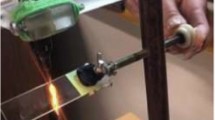Abstract
The influence of the laser beam parameters (power, motion velocity, and focus position) on the characteristics of the track being formed (size, elemental composition, and microhardness) is studied. If the difference in the laser radiation absorption coefficients in the heat conduction and keyhole regimes is taken into account, then the track sizes can be determined by a unified dependence on the energy parameter. The effect of the laser beam on the chemical composition and microhardness of cermet (WC-NiCrBSi) tracks is studied. Regardless of the track formation regime, these parameters are determined by a dimensionless parameter, which describes the degree of dilution of chemical substances. It is found that a track with the maximum mass fraction of tungsten and the greatest value of microhardness is formed at small values of the dimensionless parameter, which corresponds to the heat conduction regime. The microhardness of the deposited cermet structure is observed to be 4–5 times higher than the microhardness of the substrate material.
Similar content being viewed by others
References
Wohlers Report 2016—3D Printing and Additive Manufacturing State of the Industry: Annual Worldwide Progress Report (Wohlers Assoc. Inc., Fort Collins, 2016).
F. Bartolomeu, M. Buciumeanu, E. Pinto, et al., “316L Stainless Steel Mechanical and Tribological Behavior—A Comparison between Selective Laser Melting, Hot Pressing and Conventional Casting,” Additive Manufactur., No 16, 81–89 (2017).
L. Thijs, “Microstructure and Texture of Metal Parts Produced by Selective Laser Melting,” Dissertation (Leuven, 2014).
K. Kempen, “Expanding the Materials Palette for Selective Laser Melting of Metals,” Dissertation (Leuven, 2015).
J. P. Kruth, L. Froyen, Vaerenbergh J. Van, et al., “Selective Laser Melting of Iron-Based Powder,” J. Mater. Process. Technol., No. 49, 616–622 (2004).
D. B. Hann, J. Iammi, and J. Folkes, “A Simple Methodology for Predicting Laser-Weld Properties from Material and Laser Parameters,” J. Phys., D: Appl. Phys., No 44, 445401 (2011).
R. Rai, J. W. Elmer, T. A. Palmer, and T. DebRoy, “Heat Transfer and Fluid Flow during Keyhole Mode Laser Welding of Tantalum, Ti-6Al-4V 304L Stainless Steel and Vanadium,” J. Phys., D: Appl. Phys., No 40, 5753–5766 (2007).
S. A. Khaillarah, A. T. Anderson, A. Rubenchik, and W. E. King, “Laser Powder-Bed Fusion Additive Manufacturing: Physics of Complex Melt Flow and Formation Mechanisms of Pores, Spatter, and Denudation Zones,” Acta Mater., No. 108, 36–45 (2016).
T. Heeling, M. Cloots, and K. Wegener, “Melt Pool Simulation for the Evaluation of Process Parameters in Selective Laser Melting,” Additive Manufactur., No. 14, 116–125 (2017).
V. M. Fomin, A. A. Golyshev, V. F. Kosarev, et al., “Creation of Heterogeneous Materials on the Basis of B4C and Ni Powders by the Method of Cold Spraying with Subsequent Layer-by-Layer Laser Treatment,” Prikl. Mekh. Tekh. Fiz. 58 (5), 218–227 (2017) [J. Appl. Mech. Tech. Phys. 58 (5), 947–955 (2017)].
J. Metelkova, Y. Kinds, K. Kempen, et al., “On the Influence of Laser Defocusing in Selective Laser Melting of 316L,” Additive Manufacture, 23, 161–169 (2018).
A. M. Rubenchik, W. E. King, and S. S. Wu, “Scaling Laws for the Additive Manufacturing,” J. Mater. Process. Technol., No. 257, 234–243 (2018).
W. E. King, H. D. Barth, V. M. Castillo, et al., “Observation of Keyhole-Mode Laser Melting in Laser Powder-Bed Fusion Additive Manufacturing,” J. Mater. Process. Technol., No. 214, 2915–2925 (2017).
M. Tang, P. C. Pistorius, and J. L. Beuth, “Prediction of Lack-of-Fusion Porosity for Powder Bed Fusion,” Additive Manufactur., No. 14, 39–48 (2017).
D. B. Miracle, “Metal Matrix Composites from Science to Technological Significance,” Compos. Sci. Technol. 65(15/16), 2526–2540 (2005).
J. Rodriguez, A. Martin, R. Fernandez, and J. E. Fernandez, “An Experimental Study of the Wear Performance of NiCrBSi Thermal Spray Coatings,” Wear 255, 950–955 (2003).
D. Chaliampalias, G. Vourlias, E. Pavlidou, et al., “Comparative Examination of the Microstructure and High Temperature Oxidation Performance of NiCrBSi Flame Sprayed and Pack Cementation Coatings,” Appl. Surface Sci. 255, 3605–3612 (2009).
C. Guo, J. Zhou, J. Chen, et al., “High Temperature Wear Resistance of Laser Cladding NiCrBSi and NiCrBSi/WC-Ni Composite Coating,” Wear 270, 492–498 (2011).
M. Tobar, C. Alvarez, J. Amado, et al., “Morphology and Characterization of Laser Clad Composite NiCrBSi-WC Coatings on Stainless Steel,” Surface Coatings Technol., No. 200, 6313–6317 (2006).
K. Bonny, P. Baets, J. Vleugels, et al., “Dry Reciprocating Sliding Friction and Wear Response of WC-Ni Cemented Carbides,” Tribol. Lett., No. 31, 199–209 (2008).
A. A. Golyshev, A. G. Malikov, A. M. Orishich, and V. B. Shulyat’ev, “High-Quality Laser Cutting of Stainless Steel in an Inert Gas Atmosphere by Fiber Ytterbium and CO2 Lasers,” Kvant. Elektron. 44 (3), 233–238 (2014).
V. M. Fomin, A. A. Golyshev, A. M. Orishich, and V. B. Shulyat’ev, “Energy Balance in High-Quality Cutting of Steel by Fiber and CO2 Lasers,” Prikl. Mekh. Tekh. Fiz. 58 (2), 212–220 (2017) [J. Appl. Mech. Tech. Phys. 58 (2), 371–378 (2017)].
A. A. Golyshev, A. G. Malikov, A. M. Orishich, and V. B. Shulyat’ev, “Experimental Investigation of Laser-Oxygen Cutting of Low-Carbon Steel by Fiber and CO2 Lasers in the Case with the Minimum Roughness,” Kvant. Elektron. 44 (10), 970–974 (2014).
U. Oliveira, V. Ocelík, and J. Th. M. De Hosson, “Analysis of Coaxial Laser Cladding Processing Conditions,” Surface Coatings Technol., No. 197, 127–136 (2005).
Author information
Authors and Affiliations
Corresponding author
Additional information
Original Russian Text © A.A. Golyshev, A.M. Orishich, A.A. Filippov.
Translated from Prikladnaya Mekhanika i Tekhnicheskaya Fizika, Vol. 60, No. 4, pp. 194–205, July–August, 2019.
Rights and permissions
About this article
Cite this article
Golyshev, A.A., Orishich, A.M. & Filippov, A.A. Similarity Laws in Laser Cladding of Cermet Coatings. J Appl Mech Tech Phy 60, 758–767 (2019). https://doi.org/10.1134/S0021894419040217
Received:
Revised:
Accepted:
Published:
Issue Date:
DOI: https://doi.org/10.1134/S0021894419040217




